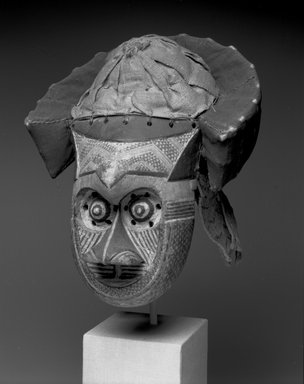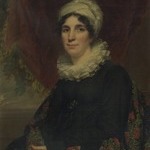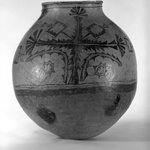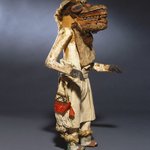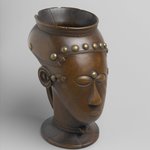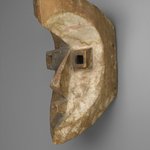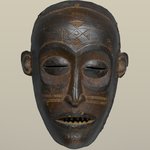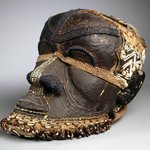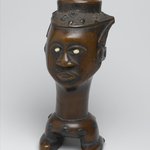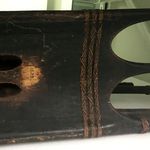Mask (Pwoom Itok)
Arts of Africa
This mask may have represented a wise older man at boys’ initiations. One of the principal Kuba dance masks is called pwoom itok. The chief identifying characteristic is the shape of the eyes, whose centers are cones surrounded by holes through which the wearer sees. Like many Kuba types of masks, pwoom itok is extensively polychromed, or multicolored. This example has a cane headdress covered with raffia cloth with painted designs and detached wooden ears. The top of the headdress was probably originally adorned with feathers, like those worn by high-ranking persons.
MEDIUM
Wood, shell, cloth, raffia, pigment
DATES
late 19th century
DIMENSIONS
15 3/8 x 11 1/4 x 11 3/4 in. (39.1 x 28.6 x 29.8 cm)
(show scale)
ACCESSION NUMBER
22.230
CREDIT LINE
Museum Expedition 1922, Robert B. Woodward Memorial Fund
PROVENANCE
Prior to 1922, provenance not yet documented; by 1922, acquired by François Poncelet of Brussels, Belgium; 1922, purchased from François Poncelet by Stewart Culin in Brussels for the Brooklyn Museum.
Provenance FAQ
CATALOGUE DESCRIPTION
Dance mask with polychrome geometric facial decoration. Round recessed eyes with cone shaped centers surrounded by holes for seeing out by wearer. Headdress covered by raffia cloth with painted designs. Attached wooden ears. The fragile raffia material has been stabilized. The mask's wood is in fair condition. Surfaces are abraded throughout.
MUSEUM LOCATION
This item is not on view
CAPTION
Kuba (Bushoong subgroup). Mask (Pwoom Itok), late 19th century. Wood, shell, cloth, raffia, pigment, 15 3/8 x 11 1/4 x 11 3/4 in. (39.1 x 28.6 x 29.8 cm). Brooklyn Museum, Museum Expedition 1922, Robert B. Woodward Memorial Fund, 22.230. Creative Commons-BY (Photo: Brooklyn Museum, 22.230_SL1.jpg)
IMAGE
overall, 22.230_SL1.jpg. Brooklyn Museum photograph
"CUR" at the beginning of an image file name means that the image was created by a curatorial staff member. These study images may be digital point-and-shoot photographs, when we don\'t yet have high-quality studio photography, or they may be scans of older negatives, slides, or photographic prints, providing historical documentation of the object.
RIGHTS STATEMENT
Creative Commons-BY
You may download and use Brooklyn Museum images of this three-dimensional work in accordance with a
Creative Commons license. Fair use, as understood under the United States Copyright Act, may also apply.
Please include caption information from this page and credit the Brooklyn Museum. If you need a high resolution file, please fill out our online
application form (charges apply).
For further information about copyright, we recommend resources at the
United States Library of Congress,
Cornell University,
Copyright and Cultural Institutions: Guidelines for U.S. Libraries, Archives, and Museums, and
Copyright Watch.
For more information about the Museum's rights project, including how rights types are assigned, please see our
blog posts on copyright.
If you have any information regarding this work and rights to it, please contact
copyright@brooklynmuseum.org.
RECORD COMPLETENESS
Not every record you will find here is complete. More information is available for some works than for others, and some entries have been updated more recently. Records are frequently reviewed and revised, and
we welcome any additional information you might have.





